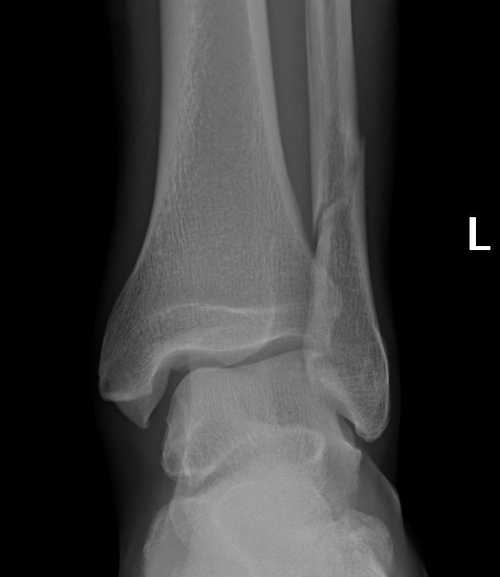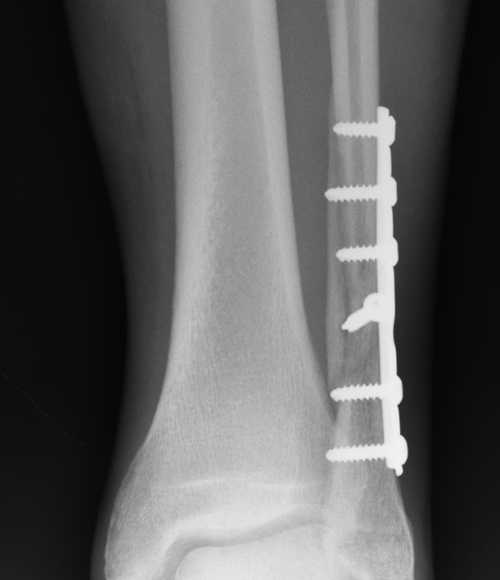That Awful “Snap”: Recovering from a Broken Ankle
Written by Bruce R. Copeland on October 15, 2011
Tags: broken ankle, cycling, fibula, fracture, nutrition, orif, orthopedic, power hiking, running, swimming, trekking poles
Some of you know I was out of commission most of this past summer after breaking my ankle on Memorial Day weekend. It has taken until now to pretty much fully recover.
This all began on a drizzly morning trail run. I had been out for about an hour and was feeling pretty good when I arrived at the wooden foot bridge over the creek in Draper Corner Canyon. This is one of those curved, wooden, Japanese-style bridges. I’ve been across it dozens of times in the past. Yes it can be treacherous on a frosty morning, but temperatures were in the high 30’s. I didn’t give it a second thought. I ran to the crest of the bridge and took one more step, at which point both my feet shot out from underneath me, and I was sliding down the bridge on my back. At the base of the bridge there is a slight lip. My left foot caught the lip, and as the leg buckled under I heard that awful “snap”. After 10 or 20 seconds of intense pain and nausea, I cautiously got up on my uninjured leg and began to test a little weight on the injured leg. Initially the foot on the injured leg was canted to the side at an odd angle. However, as soon as I put weight on the foot, I felt the ankle rotate back into correct position, and the ankle was stable again. I was about 1/4 mile from a trailhead, so I called my wife and some friends to come meet me, and I hobbled to the trailhead.
A trip to the ER and some X-rays confirmed what I had known all along. My ankle was broken. The break involved only the fibula (3 inches above the ankle bone). The fibula is basically a stabilizer rod for the ankle, but it supports only about 5% of body weight when walking, which is why I was able to hobble for 1/4 mile without intense pain. The X-rays showed the broken bone to be almost correctly lined up, so the ER doctor gave me a strap on boot cast, some crutches, and told me to see an orthopedist.
Since the bone was almost correctly aligned, I was cautiously optimistic that the ankle might heal without surgery. Two days later, I sent my ER X-rays to a local orthopedic surgeon and scheduled some more X-rays and a consult for the following week. The orthopaedist warned me in advance that broken ankles usually require surgery. The leg felt pretty good by this point, so I was shocked when the new X-rays showed that the broken bone ends had shifted about 30 degrees out of alignment. We scheduled surgery for a week later so the orthopedic surgeon could put in a plate and some screws (ORIF).
I was pretty bummed out about the movement of the bones, and I kept trying to figure out what I had done to produce this adverse outcome. Dr. Rick St. Onge, our medical director for the Logan Peak Trail Run (and a retired orthopedic surgeon), later explained it all to me. It seems that in most people with any appreciable leg muscle, the firing of the muscles tends to pull a broken fibula out of alignment when the break is within a few inches of the ankle. Full immobilization with a true leg cast is the only way to avoid the problem. Too bad the ER doctors don’t seem to know about this!
The ORIF surgery on the ankle took about an hour; the surgeon put in a plate and 6 screws. The leg was splinted for a week, and then I was back in the boot cast again full-time (without any weight on the leg). During the four weeks following surgery, I took 800-1200 mg ibuprofen per day to reduce inflammation and iced the ankle and lower leg three times per day (lots of swelling). This degree of inactivity was pretty tough to deal with, and the resulting 30% muscle atrophy in the injured leg was especially discouraging. During this time, I did leg lifts three times a week and lifted weights (upper body and good leg) several times. Twice I hiked 1.5 miles on crutches just to avoid cabin fever.
Starting 5 weeks after surgery, the doctor let me begin spinning on a stationary bike. I used a heavy duty ankle brace instead of the boot cast, and within 10 days I was spinning 2 hours per day. Six weeks after surgery I also started swimming 2-3 times a week (also with the ankle brace). It’s been nearly thirty years since I worked as a lifeguard and water safety instructor. In those days I could swim 5 miles. Now I had to settle for a slow mile. Beginning at six weeks, I also started putting up to 50 pounds of force on the leg while walking on crutches. The cycling was especially beneficial because it allowed very restrained use of the ankle and stimulated increased blood flow to the foot and ankle. Swimming was good for overall conditioning, development of leg strength, and increased ankle flexibility. However, because it pushed ankle flexion, it tended to produce swelling and some minor pain in the ankle (but not the fracture/surgery site).
I saw the orthopedist again at week 7. The X-rays of the leg showed good healing, although there was a fragment (10% of bone cross-section) that was only partially attached. The doctor said I was doing all the right things and told me to add 25 pounds more force on the leg each week. He also gave me the go-ahead to start cycling on the road and to begin hiking (with trekking poles for stability) on smooth trails that had only gentle grades (both using the ankle brace).
That week I ditched the crutches. Over the next three weeks I worked up from 1/2 mile to twelve miles power hiking. The trekking poles were an important adjunct to that recovery. Following two months of inactivity, an ankle and associated structures are quite stiff and weak (irrespective of any fracture). Without the poles I had a pronounced limp; using the poles I was able to stride fully and develop appropriate strength. During this period I was also swimming one mile twice per week and cycling for 1 to 3 hours three times per week. I had been gradually tapering my ibuprofen consumption to an occasional 200 mg.
In week 9, I began doing some light running. Initially I would run for about 30 seconds, then hike for a couple of minutes, repeating this cycle up to 25 times. (Trekking poles also helped in the transition to running.) Over the next 10 days, I increased the length of continuous running to 3 minutes and decreased the walking breaks to 30 seconds.
I saw the orthopedist the last time at week eleven. The final X-ray looked very good—nearly complete healing. He said I was free to do pretty much anything. My wife asked if that included pacing someone 25 miles for the Bear 100 in three weeks. (She and I had been having a disagreement over whether I was trying to do too much too soon.) The doctor’s answer shocked even me. He said “That sounds pretty ambitious, but you’ve healed very fast, and you seem to know what you’re doing.”
Over the subsequent 5 weeks, I’ve increased my running to 50 miles/week, including up to 25 miles on long runs. Most of my leg muscle mass has returned. I did not get to pace at the Bear 100 because my runner dropped before mile 75. I did however cover lots of miles, lots of vertical, and lots of technical terrain preparing and marking parts of the Bear 100 course. I estimate my running is about 90% recovered. I don’t have full uphill strength/speed yet, and forward flexion in the ankle still needs to improve a bit. There is some swelling/pain near but not at the upper part of the original fracture. This is just above where the top of the ankle brace would be, so it could be from the brace. It could also be related to the bone fragment which is healing more slowly, or it could simply be an area of slightly compromised circulation from the original injury. In any case it seems to be improving. I have discontinued use of the ankle brace in order to recover normal use and flexibility in the ankle and related muscles, tendons, and ligaments.
Three things seem to have most contributed to my relatively rapid rehab: proper nutrition (good intake of calcium and vitamin D and higher than normal intake of protein and antioxidants during the recovery), aggressive and extensive cycling as early as possible during recovery, and use of trekking poles while beginning to walk and run. Of course I was lucky that my accident caused no other real damage to the ankle; many others with broken ankles are not so fortunate.







